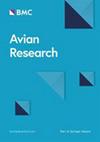Phylogeography of the endangered Yellow-headed Parrot (Amazona oratrix)
IF 1.7
2区 生物学
Q1 ORNITHOLOGY
引用次数: 0
Abstract
Elucidating the historical processes that led populations to their current spatial and genetic arrangement is relevant in conserving threatened species. We interpreted the phylogeographic structure of the threatened Yellow-headed Parrot (Amazona oratrix) with mitochondrial markers and analyzed 98 samples from Mexico, Guatemala, and Belize. We performed analyses of genetic structure, genealogical relationships, demographic history, and divergence times and illustrated the phenotypic variation qualitatively of the sampled individuals. The studies revealed that 92% of the genetic variation is explained between the Mexican Tres Marías Islands, the Mexican Pacific Coast, and the Atlantic groups. These three groups were segregated into two main lineages (Pacific and Atlantic), separated by 26 mutations, leaving A. auropalliata within the Atlantic. We found that both lineages diverged 0.55 million years ago, from which the Atlantic lineage experienced population expansion, high levels of genetic diversity, and a low genetic structure with two phenotypes. The Pacific experienced demographic stability, low levels of diversity, and a genetic structure marked with two phenotypes. Our estimates indicate that this separation occurred in the Pleistocene when the Atlantic clade diverged from Panama and dispersed overland to the Gulf of Mexico. Simultaneously, the Pacific clade departed from the same area to Tres Marías Islands and the Mexican Pacific coast. We deduce that this long-distance event was probably produced by assisted dispersal, but other scenarios appear more parsimonious. We conclude that there is no gene flow between both lineages and that the phylogeographic structure resulted significantly from historical events and climatic changes during the Pleistocene. We propose undertaking other analyses in the future to compare our results and the paraphyletic relationships in A. oratrix.

濒危黄头鹦鹉的系统地理学研究
阐明导致种群形成其当前空间和遗传安排的历史过程与保护濒危物种有关。我们用线粒体标记解释了濒危黄头鹦鹉(Amazona oratrix)的系统地理结构,并分析了来自墨西哥、危地马拉和伯利兹的98个样本。我们进行了遗传结构、家谱关系、人口统计学历史和分化时间的分析,并定性地说明了样本个体的表型变异。研究表明,92%的遗传变异可以在墨西哥特雷斯Marías群岛、墨西哥太平洋沿岸和大西洋群之间得到解释。这三个群体被分成两个主要的谱系(太平洋和大西洋),被26个突变分开,留下了在大西洋的auropalliata。研究人员发现,这两个谱系在55万年前发生分化,从那时起,大西洋谱系经历了种群扩张、高水平的遗传多样性和具有两种表型的低遗传结构。太平洋经历了人口稳定、低水平的多样性和以两种表型为标志的遗传结构。我们的估计表明,这种分离发生在更新世,当时大西洋分支从巴拿马分离出来,并通过陆地分散到墨西哥湾。与此同时,太平洋分支从同一地区出发,前往特雷斯Marías群岛和墨西哥太平洋海岸。我们推断,这一远距离事件可能是由辅助分散造成的,但其他情况似乎更为简单。我们认为这两个谱系之间不存在基因流动,系统地理结构是更新世时期历史事件和气候变化的重要结果。我们建议在未来进行其他分析,以比较我们的结果和A. oratrix的副病关系。
本文章由计算机程序翻译,如有差异,请以英文原文为准。
求助全文
约1分钟内获得全文
求助全文
来源期刊

Avian Research
ORNITHOLOGY-
CiteScore
2.90
自引率
16.70%
发文量
456
审稿时长
46 days
期刊介绍:
Avian Research is an open access, peer-reviewed journal publishing high quality research and review articles on all aspects of ornithology from all over the world. It aims to report the latest and most significant progress in ornithology and to encourage exchange of ideas among international ornithologists. As an open access journal, Avian Research provides a unique opportunity to publish high quality contents that will be internationally accessible to any reader at no cost.
 求助内容:
求助内容: 应助结果提醒方式:
应助结果提醒方式:


